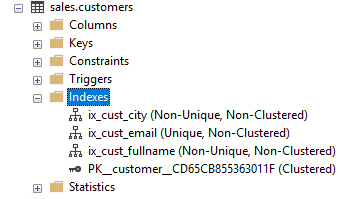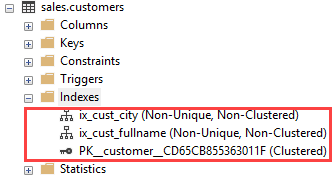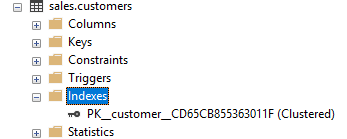Summary: in this tutorial, you will learn how to use the SQL Server DROP INDEX statement to remove existing indexes.
SQL Server DROP INDEX statement overview
The DROP INDEX statement removes one or more indexes from the current database. Here is the syntax of the DROP INDEX statement:
DROP INDEX [IF EXISTS] index_name
ON table_name;
Code language: SQL (Structured Query Language) (sql)In this syntax:
- First, specify the name of the index that you want to remove after the
DROP INDEXclause. - Second, specify the name of the table to which the index belongs.
Removing a nonexisting index will result in an error. However, you can use the IF EXISTS option to conditionally drop the index and avoid the error.
Note that the IF EXISTS option has been available since SQL Server 2016 (13.x).
The DROP INDEX statement does not remove indexes created by PRIMARY KEY or UNIQUE constraints. To drop indexes associated with these constraints, you use the ALTER TABLE DROP CONSTRAINT statement.
To remove multiple indexes from one or more tables at the same time, you specify a comma-separated list of index names with the corresponding table names after the DROP INDEX clause as shown in the following query:
DROP INDEX [IF EXISTS]
index_name1 ON table_name1,
index_name2 ON table_name2,
...;
Code language: SQL (Structured Query Language) (sql)SQL Server DROP INDEX statement examples
We will use the sales.customers table from the sample database for the demonstration.

The following picture shows the indexes of the sales.customers table:

A) Using SQL Server DROP INDEX to remove one index example
This statement uses the DROP INDEX statement to remove the ix_cust_email index from the sales.customers table:
DROP INDEX IF EXISTS ix_cust_email
ON sales.customers;
Code language: SQL (Structured Query Language) (sql)If you check the indexes of the sales.customers table, you will see that the ix_cust_email index was deleted.

B)Using SQL Server DROP INDEX to remove multiple indexes example
The following example uses the DROP INDEX statement to remove the ix_cust_city, ix_cust_fullname indexes from the sales.customers table:
DROP INDEX
ix_cust_city ON sales.customers,
ix_cust_fullname ON sales.customers;
Code language: SQL (Structured Query Language) (sql)The sales.customers table now has no non-clustered index:

In this tutorial, you have learned how to use the SQL Server DROP INDEX statement to remove one or many indexes from tables.